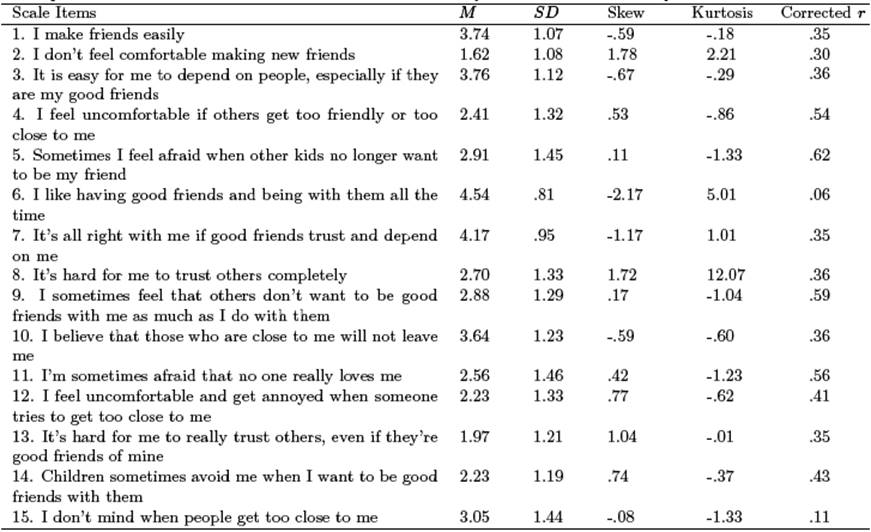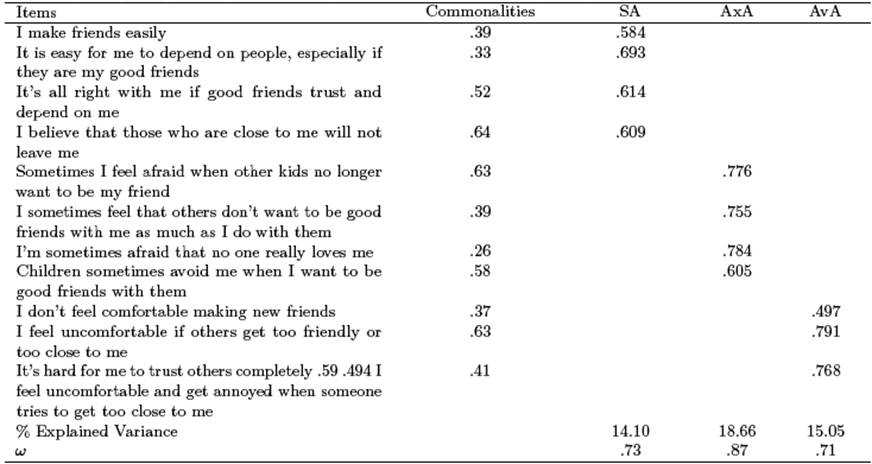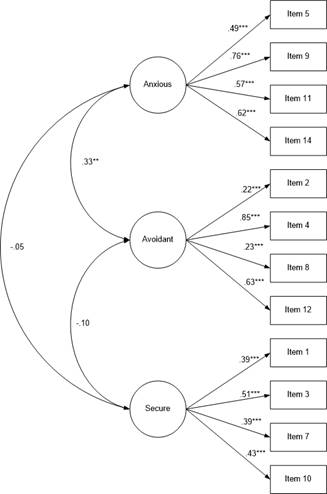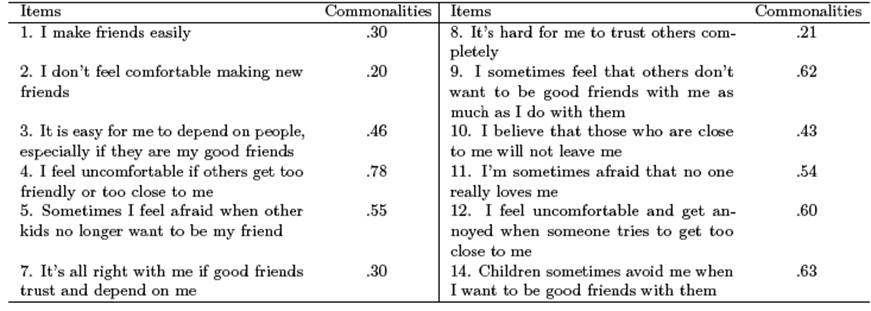1. Introduction
Beginning in childhood and continuing throughout life, the mental health of a person depends, to a large extent, on the ability to have a relationship with reliable figures that can provide emotional support and protection if needed (A. Lieberman, 2004). The attachment theory of John Bowlby (1969) refers to this universal human need to form close emotional bonds. The child needs to establish an affective bond or an attachment system with the nearest caregiver, usually the mother. This caregiver will be responsible for responding to the child signals or emotional reactions, which will allow him/her to learn how to regulate their emotional system (Fonagy, n.d.). Developed in early childhood, these attachment mecha nisms are expressed throughout life. These mechanisms, regulated by the dyadcaregiver-child, serve as scaffolding for the expansion of child’s coping abilities and, therefore, a child’s health and the subsequent mental health of the adult (Bosmans & Kerns, 2016; Kerns, Mathews, Koehn, Williams, & Siener-Ciesla, 2015).
Attachment theory has been enriched by new evaluation methods that have produced both conceptual and empirical progress in attachment theory. A fundamental aspect of the methodological approach of attachment is the developmental moment in which the exploration is carried out, since, among other issues, cognitive maturation triggers more indirect forms of the expressions of bonding needs. The activation of the attachment system elicits, in small children, an immediate behavioral reaction in relation to the care figure. As they grow, that reaction no longer manifests so explicitly at the behavioral level, and the mental representations acquired a central role in emotional regulation (Borelli et al., 2016; L. A. Sroufe, 2016).
When working with children from middle to late childhood (latency age), it is possible to use questionnaires that are important tools for screening in school and clinics. There are two types of questionnaires that can be used to assess attachment: dimensional and categorical. Categorical procedures propose taxonomies for the classification of children in different categories based on individual differences, derived from the evaluation of attachment (for example, secure attachment style, ambivalent, avoidant or disorganized). The dimensional scales proposed, for instance, are a continuous score in security (one-dimensional) or multiple dimensions (multidimensional), such as in confidence, availability or communication (Cassidy, 2003; L. Sroufe, 2003).
Although there is a lot of evidence regarding the attachment development during infancy and early childhood as well as in adolescence and adulthood (Belsky & Cassidy, 2007), relatively little attention has been given to the study of attachment in middle and late childhood (Bosmans & Kerns, 2016). In this sense, Finzi has developed the Attachment Style Classification Questionnaire for Latency Age Children (ASCQ). It is an adaptation for children of the Hebrew version (Mikulincer, Florian, & Tolmacz, 1990) of Hazan and Shaver (1987) attachment questionnaire for adults. We consider that the ASCQ is a categorical questionnaire, not in the sense of categorical or discontinuous measurement, but because it proposes a taxonomy for the classification of boys and girls in the categories of secure, anxious, and avoidant attachment (Román, 2011).
The ASCQ evaluates three attachment factors: secure, anxious/ambivalent, and avoidant, and follows Ainsworth’s three attachment patterns. The highest score obtained in one of the three factors determines the category of attachment to which each child is classified. There is a lot of evidence about the validity of this instrument that has been used with children in studies with clinical (Finzi, Cohen, Iwaniec, Sapir, & Weizman, 2003; Finzi, Cohen, Sapir, & Weizman, 2000; Finzi-Dottan, Manor, & Tyano, 2006) and non-clinical samples (Sharif, Yadegari, Bahrami, & Khorsandi, 2018; Wellisch et al., 2011).
Davis (2018) indicates that if someone is raised by warm parents, caregivers, they will have a model that fosters the increase of compassion and empathy. When adults are concerned with explaining to children that there are certain behaviors that can cause pain or help others, it stimulates the growth of empathy and prosocial behavior (Spinrad & Eisenberg, 2014). Most models of empathy agree that the helping behavior is motivated by affective states oriented towards others, which develop in the context of parental care and bond with the other (Sommerville & Decety, 2016). The sense of security leads children to adopt a more empathetic attitude not only in intimate relationships with others but towards others not so close to them. Conversely, emotional distress, which can be induced by affective arousal, interferes with empathic concern by reducing the attentional and cognitive resources that can be used to meet the needs of others and to provide adequate care to alleviate their suffering (Eisenberg & Eggum, 2009; Pallini et al., 2018).
Although it is hypothesized that there is a universal concept of attachment, the way in which mothers, fathers and families in general are linked depends on their beliefs and values as well as those of the cultural context in which these bonds develop (Otto & Keller, 1999). These cultural differences modify the beliefs and the ways in which caregivers behave, influencing how they bring up and relate to their children (Reebye, Ross, & Jamieson, 2019).
Based on these antecedents, the importance of having an Attachment Questionnaire for children of middle and late childhood and adapted to the culture in which the evaluation will be carried out is observed.
Thus, the goal of this paper is to study the psychometric properties of Attachment Style Classification Questionnaire ASCQ (Finzi, Har-Even, Weizman, Tyano, & Shnit, 1996; Finzi et al., 2000) in middle and late childhood from Argentina. To develop this goal, three studies were carried out. In the first study we will analyze the factor structure of the ASCQ using Exploratory Factor Analysis (EFA). In the second study we will confirm the factor structure of the ASCQ and we will analyze the invariance between sex and age. In the third one, we will study the convergent validity of ASCQ through the correlation with Kern’s Security Scale (multidimensional attachment scale with two dimensions: confidence and availability), Empathy Questionnaire for children, and Prosocial Behavior toward different targets.
1.1 Hypothesis
1. The factor structure of the original questionnaire will remain stable and invariant according to sex and age.
2. Secure attachment is related to the perception of parents as reliable and available, avoidant attachment is related to the perception of parents as little available, and anxious attachment is related to the perception of parents as unreliable.
3. Secure attachment is positively related to empathy and prosociality towards family, friends, and strangers, avoidant attachment is negatively related to empathy and prosociality, and anxious attachment is not related to empathy and prosociality.
2. Method
2.1 Questionnaire translation
The text was translated by a psychologist and professional translator who was familiar with the terminology of attachment. He was a native speaker of English, with professional fluency in Spanish. He was told that the translation should be conceptual rather than literal and, as much as possible, to use a simple language and to use the current Spanish typically spoken in Argentina, because it was for a questionnaire for Argentine children. Once the first translation was made, another psychologist native speaker of Spanish with expertise in translation and developing research instruments revised it for semantic and syntactic equivalence. Finally, an independent native Spanish speaker translator, without prior knowledge of the questionnaire, translated it back into Spanish. The researchers and translators made revisions until a satisfactory version was reached.
The questionnaire translation was presented to a sample of 15 children (8 girls and 7 boys) evenly representing different ages (3 children aged 9, 4 children aged 10, 4 children aged 11, and 4 children aged 12). The children were asked if the instructions and response options seemed clear to them and if the terms or expressions used in the questionnaire were understandable. Based on the children’s suggestions, the instructions, items, and response options remained intact.
2.2 Informed consent
In a first interview with the directors of the schools, the questionnaires, which were to be administered to the children, and the procedures to be employed with the data obtained, were delivered along with a note asking for the children’s collaboration and a copy of the research project. Once the commitment of the directors’ collaboration was obtained, a note was sent to the parents explaining the objectives of the general project and the tasks that we would be required from the children. It was specifically indicated that participation was voluntary and anonymous and that the child could stop participating at any time. A commitment was made not to give any individual information to principals or teachers unless the parents expressly gave their consent. No child was able to participate without the written consent of both parents. The children were told that even if we had their parents’ permission, they were free to elect not to answer. There were no objections. This procedure was followed in the three following studies.
2.3 Study 1
The objective of study 1 was to analyze the discriminative power of items, to carry out an exploratory factor analysis to determine the structure of the questionnaire and to calculate the internal consistency of factors.
2.3.1. Participants
The items were administered to a sample of 180 children, aged 9 (n = 39), 10 (n = 43), 11 (n = 48), and 12 (n = 50), (83 boys and 97 girls), living with both parents, from three primary schools, one state-run and two private, residing in the city of Buenos Aires. The schools were intentionally selected from middle class neighborhoods of Buenos Aires. The sample children were randomly selected from all the children attending the fourth, fifth, sixth and seventh grades of the three schools chosen. The criterion for inclusion was that children did not have a history of family conflicts. The exclusion criteria were to have divorced parents, and have a history of maltreatment, abuse or being in psychological therapy. The children were classified according to the GraffarMéndez Castellano Methods (Méndez-Castellano & de Méndez, 1999). This method allows to locate the participants in a stratum of socioeconomic level from I to V, being the I socioeconomic level highest and the V the lowest socioeconomic level. The children in the sample belonged to strata II and III, corresponding to the middle socioeconomic level. Table 1 shows the parents education distribution as well as that of the family head occupation.
2.3.2 Procedures
The discriminative power of items was analyzed through corrected item-total correlation, considering that the items whose item-total coefficients yield values lower than.35 are not discriminative since the correlations from .35 are statistically significant beyond the 1% level (Frías-Navarro, 2014). The exploratory factor analysis was carried out using the principal components method and oblimin rotation. To determine the number of factors, we considered it according to the theory (Finzi et al., 1996) and the results of the Scree test (Cattell, 1966; Lorenzo-Seva, Timmerman, & Kiers, 2011).
Table 1 The Mother and Father educational distribution and occupation of the head of the family distribution in the three studies
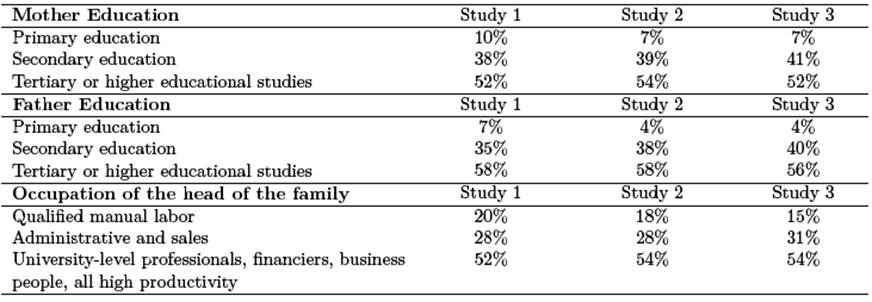
To enhance reliability through internal consistency, we used McDonald’s omega coefficient because it reflects better the level of reliability (McDonald, 2013). To be considered an acceptable reliability value by means of the omega coefficient, measurements must be between .70 and .90, although in some circumstances values greater than .65 are acceptable (Katz, 2016).
2.3.3 Results
The 15 items of the Attachment Style Classification Questionnaire (Finzi et al., 1996, 2000) were discriminative, except item 15 and especially item 6 (See Table 2).
An EFA of Argentinian version of Attachment Style Classification Questionnaire was carried out. The KaiserMeyer-Olkin (KMO) value was .70, and the Bartlett’s test of sphericity was χ 2 = 640.09; p < 0.001. Using oblimin rotation, as we did not expect independence between the factors, items weighing |.49| or more were considered for defining the factors. Following these criteria, three items (Item 6. I like having good friends and being with them all the time; Item 13. It’s hard for me to really trust others, even if they’re good friends of mine; and 15. I don’t mind when people get too close to me, one per original factors) were removed for different reasons. Item 6, which in the study of Finzi et al. (1996) corresponded to the factor of Anxious Attachment, in the Argentine sample, was weighted in the factor of secure attachment, probably due to cultural reasons. Friendship in Argentina is a cultural necessity, so it is common to want to be with friends all the time. In the case of item 13, it does not appear in the Avoidant Attachment as indicated by Finzi et al. (2000), but is weighted negatively in secure attachment. In this case, as in item 6, it would have a cultural reason, since in Argentina it would not be conceived of not to trust a best friend. Finally, the same occurs with item 15: instead of charging in secure attachment, it appears in the negative pole of avoidant, probably because Argentines enjoy physical closeness with others.
A scale of 12 items corresponding to the three factors found by the author (Finzi et al., 1996; Finzi, Shnit, & Weizman, 2002) was obtained and accounted for 47.81% of the variance (see Table 3). Moreover, the McDonald’s omega of the dimensions was .73 for secure attachment, .87 for anxious attachment, and .71 for avoidant attachment.
2.4 Study 2
The objective of study 2 was to compare the 15 items factor structure (Finzi et al., 1996, 2002) with the 12 items factor structure (adapted questionnaire), and to determine if the model obtained is invariant between sex and age.
2.4.1 Participants
The items were administered to a sample of 200 children, aged 9 (n = 49), 10 (n = 43), 11 (n = 48), and 12 (n = 53), (95 boys and 105 girls), from four primary schools, two state-run and two private, residing in the city of Buenos Aires. The children belonged to the middle socioeconomic class. The procedure followed for the school and children selection was similar to that of the study sample 1.
Table 1 shows the parents education distribution as well as that of the family head occupation.
2.4.2 Procedures
The multivariate Mardia index was calculated to determine the multivariate normality. To compare if the data from a new sample fit better the 15 items model or the 12 items model, two CFA were carried out using Maximum Likelihood Estimator. The following fit indices were examined: CFI (Comparative Fit Index), and following degree of error of the model: RMSEA (Root Mean Square Error of Approximation). To analyze if one model was better than the other, we considered the change in the Chi square for nested models (Byrne, 2010; Kline, 2015). To implement these analyses, the AMOS 19.0 (Arbuckle, 2007) program was used. With the objective to study if the model was invariant between different sexes and ages, we implemented two multi-group analyses. For measurement of invariance we used the bottom up approach, where one starts with the least constrained model (i.e. configural invariance) and then proceeds by introducing more constraints to the model (Davidov, Schmidt, & Billiet, 2012).
2.4.3 Results
Confirmatory Factor Analysis
The multivariate Mardia index was 22, indicating multivariate normality (Rodríguez Ayán & Ruiz, 2008). The values of fit indices for 15 items model were the following: χ 2(84) = 274.82, p < .000, χ 2 /df = 3.27, CFI=.76, and RMSEA=.08; and for 12 items model: χ 2(48) = 96.81, p < .000, χ 2 /df = 2.02, CFI=.92, and RMSEA=.05. The difference between the chi squares of the two models was 178.01 with 39 degrees of freedom. This difference was significant to .000. The evaluation of the adjustment indices also suggested that the 12 items model provided a better fit to the data. For CFI, the 12 items model resulted in higher adjustment indices. In addition, the adjustment index, in the 15 items model, is below what is conventionally considered an acceptable level. These results suggest that the 12 items model provides a better general fit to the empirical data. The communalities of variables for the 12 items model are presented in Table 4. The 12 items model and the values of path are presented in Figure 1. Moreover, the results indicate that the 12 items model is invariant between sex and age (See Table 5 and Table 6). In this second study, the McDonald’s omega coefficient of the ASCQ ranged between .70 and .81.
2.5 Study 3
The objective of Study 3 was to analyze the convergent validity with an attachment dimensional scale and to analyze the concurrent validity through the correlation with theoretical criteria (Empathy and Prosociality).
2.5.1 Participants
We worked with a sample of 425 children, aged 9 (n = 99), 10 (n = 103), 11 (n = 108), and 12 (n = 115), (199 boys and 226 girls), from four primary schools, two state-run and two private, residing in the city of Buenos Aires. The children belonged to the middle socioeconomic class. The schools were intentionally selected from middle class neighborhoods of Buenos Aires. The procedure followed for the school and children selection was similar to that of the study sample 1 and 2. Table 1 shows the parents education distribution as well as that of the family head occupation.
2.5.2 Instruments
1. Kerns’ Security Scale (Argentine adaptation by Richaud de Minzi, 2006; Kerns, Klepac, & Cole, 1996):
The Security Scale (Kerns et al., 1996) is a selfreport questionnaire, which assess the perception that children have of their parents as reliable, available and with which it is easy to communicate, while being attentive to their needs for help and comfort (Kerns et al., 1996). The questionnaire provides a score in a continuous dimension of attachment security. It is also possible to obtain a score in the dimensions confidence and availability in the attachment figure (M. Lieberman, Doyle, & Markiewicz, 1999).
In the Argentine adaptation, only 10 of the 15 items of the questionnaire were maintained (five corresponding to confidence and five corresponding to availability). In that adaptation a sample of 1,423 boys and girls, 9 to 12 years old, of middle socioeconomic level was studied. Exploratory factor analysis of the 10 items showed two factors in both mother and father: confidence and availability, whose alpha coefficients were: Confidence α=.70 for the mother, α=.69 for the father; Availability α=.71 for the mother, α=.70 for the father (Richaud de Minzi, 2006).
Table 5 Variables commonalities in CFA

Note: Model 1 (Unconstrained), Model 2 (Measurement weights), Model 3 (Structural covariance), Model 4 (Measurement residuals).
Table 6 Fit indexes for 12 items model invariance tests across ages

Note: Model 1 (Unconstrained), Model 2 (Measurement weights), Model 3 (Structural covariance), Model 4 (Measurement residuals).*** p <.001
In the present study, the alpha coefficients for both parents took together were Confidence α=.71 and Availability α=.70. 2. Empathy Questionnaire for children aged 9 to 12 years (Richaud, Lemos, Mesurado, & Oros, 2017): Empathy Questionnaire for children aged 9 to 12 years integrated the following aspects: emotional contagion, self-other awareness, perspective-taking, emotional regulation, and empathic action. It contains 15 items, three for each dimension, which are answered on a 5-point scale (from always to never). The questionnaire demonstrated adequate reliability and construct validity (Richaud et al., 2017). In this study, McDonald’s omega coefficients ranged from .71 to .83. 3. Prosocial Behavior toward different target.
This questionnaire was taken out from Values in Action Inventory of Strengths (Peterson & Seligman, 1999) in a revised version of the Kindness and Generosity subscale (Spanish version by Mesurado & Richaud, 2017; Padilla-Walker & Christensen, 2011; Richaud et al., 2017; Mesurado, Guerra, De Sanctis, & Rodriguez, 2019) and was used to study prosocial behavior. It has 27 items, divided into three groups of 9 that correspond to the different targets: friend, stranger, and family (sample items). The items are answered in a 5-point Likert scale (from not like me at all (1) to very much like me (5)). Cronbach’s alphas in previous studies were .82 for prosocial behavior toward friend, .70 prosocial behavior toward stranger, and .87 for prosocial behavior toward family (Mesurado & Richaud, 2017). In the present study, alphas were .81 for prosocial behavior toward stranger, .87 for prosocial behavior toward friend, and .88 for prosocial behavior toward family.
2.5.3 Procedures
The instruments were administered in group form, at two different times, to avoid fatiguing the children. Two scales were completed in the first session (12 items attachment questionnaire and Argentine adaptation of Kerns’ Security Scale) and two in the second (Empathy Questionnaire for children and Prosocial Behavior toward different target). The order of administration was held constant for all school groups.
Convergent Validity
Significant and positive correlations were observed in Secure Attachment between the results of the dimensions (confidence and availability) of the Kerns Security Scale in parents and ASCQ, especially with confidence. Avoidant Attachment presents significant negative correlation with parents’ confidence, but no significant negative correlation with availability. Finally, Anxious Attachment is negatively correlated with parents’ confidence and availability, but only significant with availability (see Table 7).
Concurrent Validity
Significant and positive correlations were observed between the results of the empathy dimensions (Emotional contagion, perspective taking, and empathic attitude) and prosocial behavior with ASCQ. Avoidant Attachment presents no correlations with empathy and significant negative correlations with prosociality. Finally, Anxious Attachment presents no correlation with the three dimensions of empathy, nor with prosociality (see Table 7).
In this third study, the McDonald’s omega coefficient of the ASCQ ranged between .75 and .83.
3. Discussion
The intent of this article was to perform the psychometric study of a questionnaire of attachment for children from 9 to 12 years of age in the Argentine population. As established in the first hypothesis, the questionnaire was structured using the three categories proposed by the author: secure, anxious and avoidant attachment, although it included only 12 of the original 15 items. This structure remained invariant through the sex and age of the children. The reliability values of internal consistency were satisfactory.
To analyze the convergent validity, a correlation between the Kern’s Security Scale and the ASCQ questionnaires was made. Although one of the questionnaires is dimensional and the other categorical, there was, as expected, a significant positive correlation between the confidence and availability dimensions and secure attachment, avoidant attachment presents a negative significant correlation with parent’s confidence, and anxious attachment presents a significant and negative correlation with parent’s availability (Hypothesis 2). These findings are in line with the theoretical assertion that these securely attached children would have a mental model of the caregiver as responsive and available (Dwyer, 2005). It is interesting to observe that the anxious attachment category was negatively associated with the availability dimension, while avoidance attachment category was negatively associated with the confidence dimension. Indeed, the anxious attached child would have a mental model of the caregiver as inconsistent with their emotional skills, and the child would not have confident expectations regarding the caregiver’s access and response. Finally, the avoidant attached child would have a mental model of a caregiver as constantly neglecting signs of the child’s need for protection, which does not allow the development of the feeling of confidence that a child needs. He/she may feel insecure toward others and expect to be displaced by past experiences of abandonment (Siegel & Hartzell, 2005). It is interesting to observe how the different categories of attachment of ASCQ are described according to the Kerns’ dimensions with which they are correlated.
To analyze the concurrent validity, the attachment categories obtained in the ASCQ were correlated with the dimensions of empathy: emotional contagion, perspective taking and empathic attitude (Richaud et al., 2017), as well as with prosociality (Mesurado & Richaud, 2017; Richaud, Mesurado, & Lemos, 2018). The results supported the Hypothesis 3, indicating significant and positive correlations of secure attachment with all the dimensions of empathy mentioned above, and with prosociality. In contrast, and as expected, the avoidant and anxious categories did not correlate with dimensions of empathy. However, the avoidant attachment correlated negatively with the three types of prosociality, while the anxious one was not associated with prosociality. These results are in line with the theory of attachment. Several studies have demonstrated the connection between attachment style and empathy, indicating that children with secure attachment bonds are more prosocial (Weinfield, Srouffe, Egeland, & Carlson, 2010). At the same time, attachment security is the base for empathic concern, care, and forgiveness (Decety & Svetlova, 2011). Numerous studies have affirmed the existence of a connection between attachment and care systems that allow us to understand empathic responses (Mikulincer & Shaver, 2005; Ruckstaetter, Sells, Newmeyer, & Zink, 2017). Mikulincer and Shaver (2005) affirm that attachment relationships not only impact empathy, but that secure attachment fosters compassion, altruism and the desire to aid and comfort others who suffer. Possibly, the relationship between secure attachment and empathy is based on the direct and indirect role of attachment figures throughout the development (Mikulincer & Shaver, 2005). Davis (2018) argues that secure attachment, autonomy, and prosocial behavior are related. It is believed that a child that develops secure bonds with their parents will be less concerned about their emotional needs. This autonomy will let him look after other people at the times he thinks that the world is a safe and friendly place. Individuals who were evaluated as avoidant have less tendency to forgive and are characterized by lack of empathy (Burnette, Davis, Green, Worthington, & Bradfield, 2009; Richaud et al., 2018).
Table 7 Correlations between ASCQ with Kern’s confidence and availability and with prosocial behavior and empathy dimensions

Note: SA: Secure Attachment; AxA: Anxious Attachment; AvA: Avoidant Attachment * p <.05, ** p <.01, *** p <.001.
The indifference reaction of avoidant attachment persons could be the consequence of protecting themselves from potential sources of pain and/or negative emotions that match the traditional profile of avoidant children (Marvin & Britner, 1999). High values of avoidant attachment were negatively associated with empathic reactions towards others in distress as well as with prosocial behaviors (Gillath et al., 2005).
Anxious attachment, related with negative models of the self, is connected with the inhibition of empathy and the increase of self-discomfort. When confronted with someone else who suffers, individuals with anxious attachment cannot move the focus off of themselves to provide help. Individuals with anxious attachment show personal discomfort in front of someone who needs help but cannot transform it into altruistic action (Mikulincer, Shaver, Gillath, & Nitzberg, 2005).
4. Conclusion
In the present work, the psychometric study of ASCQ in Argentine population was carried out, founding that the factor structure of the original questionnaire remained stable, and that indices of reliability, convergent, and concurrent validity were satisfactory.
The present study contributes to clinical practice, as it provides mental health professionals with an instrument with proven psychometric properties.
The interest of adapting the ASCQ to Argentina lies in the scarcity of adequately validated attachment questionnaires in our environment.
It is a short and simple questionnaire suitable for screenings to evaluate the elements that make up the internal attachment models of children from 9 to 12 years old, which enables the understanding of their emotional needs and intervene when necessary (Román & Palacios, 2010).
As the mental health of a person depends greatly on the ability to have secure bonds with reliable figures, the impact of having valid and reliable instruments for the evaluation of them is important, especially if it results in a fast intervention when alterations are diagnosed.
This study does have some limitations. First, the sample is not probabilistic, and it is restricted to eleven schools in the city of Buenos Aires. Next, it is important to extend the sample in size and space. In future studies, it may be appropriate to use samples with children belonging to different sociodemographic strata and from different geographical regions.













